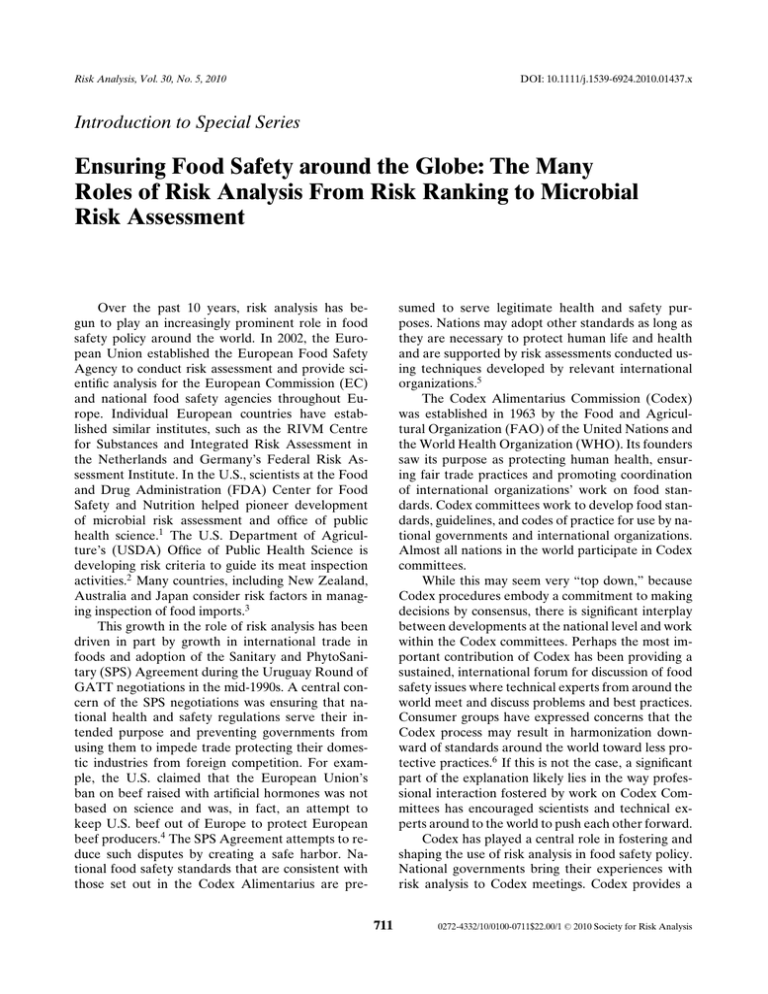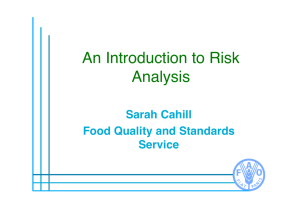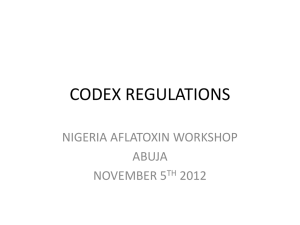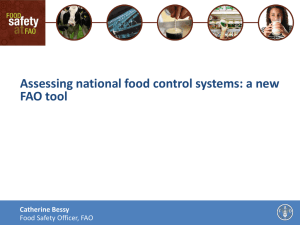Ensuring Food Safety around the Globe: The Many Risk Assessment
advertisement

Risk Analysis, Vol. 30, No. 5, 2010 DOI: 10.1111/j.1539-6924.2010.01437.x Introduction to Special Series Ensuring Food Safety around the Globe: The Many Roles of Risk Analysis From Risk Ranking to Microbial Risk Assessment Over the past 10 years, risk analysis has begun to play an increasingly prominent role in food safety policy around the world. In 2002, the European Union established the European Food Safety Agency to conduct risk assessment and provide scientific analysis for the European Commission (EC) and national food safety agencies throughout Europe. Individual European countries have established similar institutes, such as the RIVM Centre for Substances and Integrated Risk Assessment in the Netherlands and Germany’s Federal Risk Assessment Institute. In the U.S., scientists at the Food and Drug Administration (FDA) Center for Food Safety and Nutrition helped pioneer development of microbial risk assessment and office of public health science.1 The U.S. Department of Agriculture’s (USDA) Office of Public Health Science is developing risk criteria to guide its meat inspection activities.2 Many countries, including New Zealand, Australia and Japan consider risk factors in managing inspection of food imports.3 This growth in the role of risk analysis has been driven in part by growth in international trade in foods and adoption of the Sanitary and PhytoSanitary (SPS) Agreement during the Uruguay Round of GATT negotiations in the mid-1990s. A central concern of the SPS negotiations was ensuring that national health and safety regulations serve their intended purpose and preventing governments from using them to impede trade protecting their domestic industries from foreign competition. For example, the U.S. claimed that the European Union’s ban on beef raised with artificial hormones was not based on science and was, in fact, an attempt to keep U.S. beef out of Europe to protect European beef producers.4 The SPS Agreement attempts to reduce such disputes by creating a safe harbor. National food safety standards that are consistent with those set out in the Codex Alimentarius are pre- sumed to serve legitimate health and safety purposes. Nations may adopt other standards as long as they are necessary to protect human life and health and are supported by risk assessments conducted using techniques developed by relevant international organizations.5 The Codex Alimentarius Commission (Codex) was established in 1963 by the Food and Agricultural Organization (FAO) of the United Nations and the World Health Organization (WHO). Its founders saw its purpose as protecting human health, ensuring fair trade practices and promoting coordination of international organizations’ work on food standards. Codex committees work to develop food standards, guidelines, and codes of practice for use by national governments and international organizations. Almost all nations in the world participate in Codex committees. While this may seem very “top down,” because Codex procedures embody a commitment to making decisions by consensus, there is significant interplay between developments at the national level and work within the Codex committees. Perhaps the most important contribution of Codex has been providing a sustained, international forum for discussion of food safety issues where technical experts from around the world meet and discuss problems and best practices. Consumer groups have expressed concerns that the Codex process may result in harmonization downward of standards around the world toward less protective practices.6 If this is not the case, a significant part of the explanation likely lies in the way professional interaction fostered by work on Codex Committees has encouraged scientists and technical experts around to the world to push each other forward. Codex has played a central role in fostering and shaping the use of risk analysis in food safety policy. National governments bring their experiences with risk analysis to Codex meetings. Codex provides a 711 C 2010 Society for Risk Analysis 0272-4332/10/0100-0711$22.00/1 712 forum in which they can build on each other’s experience, harmonize recommendations on best practices and promote the broader use of risk analysis to improve food safety policy. In 1991, the FAO and WHO recommended that Codex use risk analysis principles in its decision-making.7 Throughout the 1990s, FAO and WHO convened several expert consultations to advise Codex on the use of risk analysis in food safety policy.8 Since 2000, the Codex Commission has developed general principles of risk analysis as guidance to national governments as well as guidance on risk analysis on specific issues like establishment of allowable pesticide residue levels.9 These Codex developments have not occurred in a vacuum: the period since 1990 has also been one of significant upheaval and reform for food safety policy in many countries. The crisis associated with bovine spongiform encephalopathy in the United Kingdom precipitated passage of Europe’s General Food Law in 2002 and national level reforms throughout Europe.10 Risk analysis was a central organizing concept in this reform effort. In the United States, a series of food safety crises since the late 1980s have facilitated a gradual shift in food law from a focus on quality to a focus on protecting public health through preventive, risk-based policies.11 Risk analysis has played a central role in shaping this shift. U.S. government agencies have been required to conduct risk and cost-benefit analysis to justify regulatory action since 1985.12 Risk analysis is also a central to food safety reform legislation currently pending before U.S. Congress. And when New Zealand and Australia streamlined their government structures in the early to mid-1980s as part of an economic reform effort, risk analysis and a goal of public health protection were central components of their new food safety laws as well.13,14 The purpose of this special issue is to highlight some of the research underway around the world as part of this global move toward risk-based food safety policy. One way to think about the contribution risk analysis can make to food safety policy could be as a hierarchical, nested sequence of analyses that help decision-makers hone in on where their efforts would reduce risk most. At the most aggregate level, there are basic risk ranking exercises and efforts to monitor the emergence of new hazards. At the most detailed level, microbial risk assessment examining the way a particular pathogen hazard emerges in the process of supplying a particular food helps risk managers to pinpoint appropriate control points. Editorial All national governments have limited resources and need to set goals. There is a long history of looking to risk ranking to help inform broad priority setting. Despite controversies regarding the effectiveness of risk ranking as a basis for setting broad policy priorities, it remains a logical place to start in thinking about how to most effectively reduce population health risks.15 This basic analysis is going on at a global level through efforts like the new WHO Initiative to Estimate the Global Burden of Foodborne Diseases.16 The goal of this project is for the first time to provide an assessment of the worldwide distribution of foodborne illness. Such information can inform the targeting of public health investments designed to reduce the incidence of foodborne illness. It can also inform firms and national governments about the general conditions in countries where food imports are being produced. To those outside the food safety arena, it may seem surprising to learn that national food safety authorities have only recently begun to look to risk ranking as a means of informing broad priority setting.17 Mangen et al. report on early discussions about foodborne illness risk ranking held at a 2006 international conference sponsored by the European MedVet-Net and the U.S. Food Safety Research Consortium on Priority Setting of Foodborne and Zoonotic Pathogens. Their paper identifies key principles that emerged from the conference and challenges that will like be confronted in any effort to use risk ranking to inform food safety priorities. The articles by Lake et al. and Ruzante et al. report on two of the several national risk ranking efforts underway around the world. Lake et al. describe an effort to rank the foodborne disease burden in New Zealand of six major pathogens. Ruzante et al. present a Canadian study ranking six food/pathogen pairs. As efforts to develop foodborne risk ranking are undertaken around the world, a certain level of coordination in choice of outcome measures will enhance their usefulness. Because illnesses differ in their severity, WHO turned to use of Disability Adjusted Life Year measures to provide a common metric of the public health impacts of these illnesses. The New Zealand and Canadian studies also use DALY measures. But food safety is not only a public health concern, it is also an economic and cultural one, as the SPS Agreement recognizes. Both the Canadian and New Zealand studies presented in this issue combine use of conventional health outcome measures and economic measures of the social burden of these diseases. The Canadian study by Ruzante et al. also Editorial develops measures of market impact, consumer risk attitudes, and social sensitivity. They combine these in a multi-factorial risk prioritization framework as an aid to risk management decision-making. European food safety law reform was motivated in large part by a crisis in public trust of UK and European handling of the BSE crises. Baker et al. propose integration of stakeholder involvement throughout food safety risk analysis in part as a means of preventing such a crisis in trust in the risk analysis procedure. But they also attempt to show how such involvement could improve the accuracy of risk assessment by bringing information to bear that might not be otherwise available. At the same time, they recognize and explore potential conflicts of interest posed by such involvement. Information from broad rankings of the social burden of foodborne disease can lead to more targeted analysis aimed at specific decision needs. For example, broad food-category risk rankings may feed into a risk-based screening process for determining the intensity with which food is inspected. Govindaraju et al. evaluate use of such a risk-based inspection strategy by the New Zealand Food Safety Authority. Risk ranking can also indicate where more detailed priority setting is needed. Kosmider et al. show how having identified VTEC O157 infections from meat and dairy as an area of policy concern, comparative microbial risk assessment could be used to identify the relative risk of different meat products to better target interventions. At times, food safety and public health officials need to manage virtually unknown risks. Roger Cooke develops a new application of expert elicitation methodologies to identify factors that influence the potential riskiness of emerging zoonotic pathogen threats. His research is designed to assist public health authorities in identifying the most critical indicators that a pathogen of concern is emerging. In a sense, this task can be thought of as analogous to the task plant managers face in designing a Hazard Analysis and Critical Control Point (HACCP) system – identifying the critical points in the system and developing the monitoring capacity to know that these are in control. If risk ranking of health endpoints provides a broad picture of the distributional impact of food safety risks in the population, risk assessment provides a more detailed picture of how these risks are generated. Using microbial risk assessment (MRA) for evaluating foodborne pathogens is a relatively new application. Even though MRA has been 713 conducted for decades to support policy development in water quality management and space exploration, as late as the early 1990s, there were serious doubts about the feasibility of applying it to food safety.18 Pioneering efforts by scientists at U.S. FDA, USDA, and FAO/WHO largely resolved these doubts.19,20 The journal literature on microbial risk assessment of foodborne hazards has burgeoned, much of it in the pages of Risk Analysis. Peg Coleman reviews two new books on microbial risk analysis of food, Microbial Risk Analysis of Foods, edited by Donald Schaffner, and Food-Borne Microbes: Shaping the Host Ecosystem, edited by Lee-Ann Jaykus, Hua Wang, and Larry Schlesinger. Coleman’s review provides readers with an excellent overview of these works. While they are described as advanced textbooks for the experience scientist, Coleman suggests ways in which others may profitably use the books. The final five papers in this special issue provide examples of how risk assessment is being applied to inform specific food-safety policy decisions. They can be seen as the most detailed level of the nested hierarchy of analysis informing food safety management priorities. Three of these papers provide examples of the how far microbial risk assessment has come in the past decade and a half. Bollaerts presents a quantitative microbial risk assessment evaluating the technical effectiveness of interventions at different points from farm to fork in the Belgian minced-pork product supply chain. Sanchez-Vizcaine et al. present the results of a microbial risk assessment of the risk of avian influenza introduction into Spain through international poultry trade. This information could contribute to the development of import safety risk factors for poultry as might be used in an import screening system like that described by Lake and his colleagues for New Zealand. Ellouze et al. show how new methods of sensitivity analysis can be used to better understand factors affecting the level of Listeria monosytogenes contamination in vacuum packed salmon. This is the kind of research that supports risk-based inspection policies like the one USDA Food Safety Inspection Service has used to help improve control of Listeria m. in ready-to-eat meat production.21 While microbial hazards are currently the major focus of food safety policy, chemical hazards remain a concern. Cardoso et al. present an assessment of human health risks from heavy metal contamination of fish consumed in Portugal. Fish consumption is of particular interest for health policy because of the trade-off between the benefits of fish 714 Editorial oil and the increasingly common problem of heavy metal contamination. Fransen et al. propose a tiered, decision-analytic approach to assessing this kind of risk/benefit trade-off. Those interested in managing the risk assessment process efficiently will find their use of stopping rules to determine how much detail is needed of particular interest. As an economist, it would be bad form if I did not point out, of course, that the results of risk ranking or even technical modeling of a risk generation process are not the only information that is needed to make good risk policy decisions. It also matters how effectively and how inexpensively risk can be reduced. And at an even deeper level, it can be useful to recognize that neither costs nor hazard levels are fixed or naturally occurring values. More often they change as a result of predictable human response to a changing economic environment. Research is needed to evaluate the usefulness of replacing fixed parameter values in risk assessments with estimates of these functional relationships. Such modeling could allow risk assessors to predict how risk is likely to change in response to changes in a food system manager’s decision environment.22,23 For more insight, readers should keep an eye out for another special issue on risk policy and behavior economics forthcoming in a future issue of Risk Analysis. Sandra Hoffmann Fellow, Resources for the Future shoffman@rff.org REFERENCES 1. Buchanan R, Dennis S. Conduct of quantitative microbial risk assessments by U.S. Food and Drug Administration’s Center for Food Safety and Applied Nutrition: Lessons learned, undated. Available at http://www.foodrisk.org/exclusives/ cqmra.pdf (accessed May 2, 2010). http://birenheide.com/ sra/2004AM/program/singlesession.php3?sessid=W13 (accessed May 2, 2010). 2. USDA, Food Safety Inspection Service (FSIS). Risk-based Sampling for Escherichia coli O157:H7 in Ground Beef and Beef Trim. USDA, FSIS, 2008. FSIS Risk Assessment for Risk-Based Verification Sampling of Listeria monocytogenes, 2007. 3. U.S. General Accountability Office (GAO). Food Safety: Selected Countries’ Systems Can Offer Insights into Ensuring Import Safety and Responding to Foodborne Illness, 2008. 4. Goldstein B, Carruth R. The precautionary principle and/or risk assessment in World Trade Organization decisions: A possible role for risk perception. Risk Analysis, 2004; 24:491–499. 5. Food and Agricultural Organization of the United Nations (FAO). Understanding the Codex Alimentarius- Revised and Updated, 2005. 6. Silverglade B. The WTO Agreement on Sanitary and Phytosanitary Measures: Weakening food safety regulation to facilitate trade. Presentation at WTO: Linking with development, (Amsterdam, May 25, 2000) sponsored by South-North Federation on Developmental Perspectives of the World Trade Organization. Available at: http://www.cspinet.org/ reports/codex/dutch wto.html (accessed May 4, 2010). 7. FAO/WHO. Food Safety Risk Analysis: A Guide for National Food Safety Authorities. FAO, Food and Nutrition Paper 87, 2006. 8. FAO/WHO. Food Safety Risk Analysis: A Guide for National Food Safety Authorities. FAO, Food and Nutrition Paper 87, 2006. 9. FAO/WHO. Food Safety Risk Analysis: A Guide for National Food Safety Authorities. FAO, Food and Nutrition Paper 87, 2006. 10. Alemanno A. Trade in Food: Regulatory and Judicial Approaches in the EC and the WTO, London: Cameron May, 2007. 11. Merrill R. The centennial of U.S food safety law: a legal and administrative history. In Hoffmann S and Taylor M (Eds.), Toward Safer Food: Perspectives on Risk and Priority Setting (pp. 23–26). Washington, DC: RFF Press, 2005. 12. Congressional Research Service. Risk Analysis: Background on Environmental Protection Agency Mandates II. (1998). Available at: http://ncseonline.org/nle/crsreports/risk/rsk-12a. cfm#General Mandates for Analysis of Regulations (accessed May 2, 2010). 13. Schwartz H. Small states in big trouble: State reorganization in Australia, New Zealand, Denmark and Sweden in the 1980s. World Politics, 1994; 46(4):527–555. 14. Giddens R. Regulation of food hygiene in New Zealand. J. of Environmental Health, 1995; 57:32. 15. Finkel A, Golding D (Eds). Worst Things First? The Debate over Risk-Based National Environmental Priorities, Washington, DC: RFF Press, 1994. 16. Lopez A, Mathers C, Ezzati M, Jamison D, Murray C. Global Burden of Disease and Risk Factors, Washington, DC: World Bank and Oxford U. Press, 2006. 17. Taylor M. Toward an integrated, risk-based food safety system: Constructing the analytical tools. In Hoffmann S, Taylor M (Eds.), Toward Safer Food: Perspectives on Risk and Priority Setting (pp. 23–26), Washington, DC: RFF Press, 2005. 18. North DW, Judd BR, Pezier JP. Life Sciences and Space Research XIII, in Sneath PA (Ed.), pp. 103–109. Berlin: Akademie-Verlag, 1975. 19. World Health Organization. Application of Risk Analysis to Food Standards Issues: Report of the Joint FAO/WHO Expert Consultation, 1995. Available at: ftp://ftp.fao.org/es/esn/ food/Risk Analysis.pdf. Accessed May 2, 2010. 20. Schroeder C, Jensen E, Miliotis M, Dennis S, Morgan K. Microbial risk assessment. In Simjee S. (Ed.), Foodborne Disease. Totowa, N.J.: Humana Press, 2007. 21. USDA, Food Safety Inspection Service. (2007). FSIS Risk Assessment for Risk-based Verification Sampling of Listeria Moncytogenes. 22. Williams R, Thompson K. Integrated analysis: Combining risk and economic assessments while maintaining separation of powers. Risk Analysis, 2004; 24(6):1613–1623. 23. Hoffmann S. Overcoming barriers to integrating economic analysis into risk assessment. Paper submitted to Risk Analysis.




